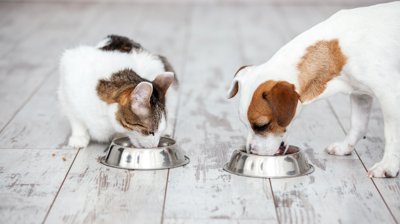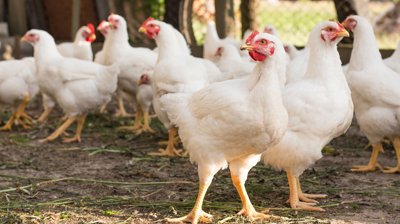What are Mannan Oligosaccharides (MOS) & what are their benefits?
Strengthening the immune system of both domestic and livestock animals is crucial, and mannan oligosaccharides animals can play a role in limiting the negative effects of gut pathogens increasing resistance against infections. Read on to discover how mannan oligosaccharides (MOS) work, and learn more about their as well as their potential benefits for animal health and wellbeing.
What are mannan oligosaccharides (MOS)?
Mannan oligosaccharides (MOS) are prebiotics made up of complex carbohydrate molecules often derived from the cell walls of yeast. MOS are widely used in animal feed for livestock and poultry and they are becoming more common as a nutritional supplements for domestic animals (such as dogs and cats). Known for their ability to improve animal health and performance by strengthening the immune system and reducing the risk of harmful infections, mannan oligosaccharides are increasingly recognised as a valuable component in animal diets.
How do mannan oligosaccharides support animal immune systems?
The mannan oligosaccharides found in yeast cell walls have a specific cell-structure which can bind to gut pathogens and prevent them from binding to gut receptors. This limits the pathogens’ ability to colonise and in turn increases the body’s resistance to microbial infections.
For example, Ohly-GO MOS consists of premium autolyzed yeast cell walls with a high mannan-oligosaccharide content to help increase protection against microbial infections. Ohly-GO Wall also utilises mannan oligosaccharides in combination with yeast beta-glucans to increase microbiome resilience as well as mitigating the growth of pathogens.
What are the benefits of mannan oligosaccharides (MOS) in animal husbandry?
Given the recent banning of antibiotic growth promoters in animal feed in many countries, mannan oligosaccharides could play a vital role in controlling microbial infections in animal husbandry1 and aquaculture.
Studies show how MOS can enhance immunity and stimulate immune cells2, such as macrophages and lymphocytes, in order to improve the body’s response to threats. There is also evidence to suggest that MOS possess anti-inflammatory properties, helping to modulate immune responses and mitigate chronic inflammation3.
As well as lowering the chance of infection, MOS also enhance the growth of beneficial gut bacteria, leading to better nutrient absorption and digestion4. In addition mannan oligosaccharides have been shown to improve the palatability1 of pet food or animal feed, encouraging regular consumption of essential nutrients.
Overall, this all leads to improved animal performance in terms of weight gain and feed efficiency, contributing to healthier livestock and increased productivity.
What to consider when choosing mannan oligosaccharides?
When choosing the right mannan oligosaccharide product, it’s important to consider the quality and consistency of the product, and how this will affect performance under farming conditions. Yeast cell walls can vary in their composition and structure as a result of the growth conditions, production process, and even the strain of yeast itself. Ohly-GO MOSs and Ohly- GO Wall prioritise the robust composition of yeast cell walls5. This focus makes them work better than regular yeast products based on Brewer's spent yeast, whose quality might fluctuate depending on the source.
Ohly utilises different production technologies to produce MOS products to achieve specific results. In Ohly- GO MOS, the yeast cell walls are autolyzed whilst the yeast cells in Ohly GO Wall are hydrolyzed. The products differ in MOS to glucan ratio, each offering their own unique immune-response support. Autolyzed yeast cell walls in Ohly-GO MOS retain more of their original structure, so they provide a high mannan-oligosaccharide content with a cell-structure ideal for binding to gut pathogens. In contrast, hydrolyzation process used in Ohly-GO Wall serves to cut off certain branches of the MOS structure on the outer surface of the yeast cell wall, leaving more glucans exposed. As a result, both MOS and beta-glucans can act together within the animal gut to increase the resilience of the microbiome and limit the colonisation of gut pathogens.
At Ohly, we’re always searching for new ways to refine our existing ingredients to meet customer demands. Our teams are focused on delivering consistent, reliable products and they continuously innovate to develop new ways to support animal health. Get in touch today to find out how Ohly’s yeast mannan oligosaccharides can work in your animal feed products.
Last updated: 25/3/2025
Find out more
If you’d like to find out more about our products with mannan oligosaccharides and how they can be used in animal feed, get in touch with our team today.
References
1. Kore, K. B., Pattanaik, A. K., Das, A., & Sharma, K. (2012). Evaluation of mannan oligosaccharides as prebiotic functional food for dogs: effect on nutrient digestibility, hind gut health and plasma metabolic profile. Indian J. Anim. Sci, 82, 81-86.
2. Kwiatkowski, S. & Edgar, S. (2012). Yeast (Saccharomyces cerevisiae) Glucan Polysaccharides – Occurrence, Separation and Application in Food, Feed and Health Industries. InTech. doi: 10.5772/48100
3. Hoving LR, van der Zande HJP, Pronk A, Guigas B, Willems van Dijk K, van Harmelen V. Dietary yeast-derived mannan oligosaccharides have immune-modulatory properties but do not improve high fat diet-induced obesity and glucose intolerance. PLoS One. 2018 May 3;13(5):e0196165. doi: 10.1371/journal.pone.0196165.
4. Zheng C, Zhou J, Zeng Y, Liu T. Effects of mannan oligosaccharides on growth performance, nutrient digestibility, ruminal fermentation and hematological parameters in sheep. PeerJ. 2021 Jun 30;9:e11631. doi: 10.7717/peerj.11631.
5. Van der Werf, M. MOS Products: Not every Yeast Cell Wall is created equal




